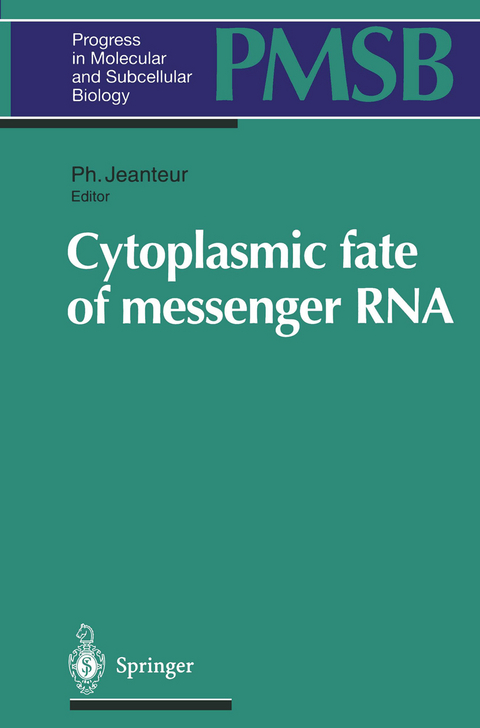
Cytoplasmic fate of messenger RNA
Springer Berlin (Verlag)
978-3-642-64420-7 (ISBN)
TOP Genes: A Translationally Controlled Class of Genes Including Those Coding for Ribosomal Proteins.- 1 Introduction.- 2 TOP Genes and TOP mRNAs.- 3 Phenomenology of the Translational Regulation of TOP mRNAs.- 4 Some Features of TOP mRNA and of Its Translational Regulation.- 5 Mechanism of Translational Regulation of TOP mRNAs.- References.- RNase L: Effector Nuclease of an Activatable RNA Degradation System in Mammals.- 1 Introduction.- 2 The Interferons.- 3 The 2-5A Pathway.- 4 RNase L.- 5 RLI.- 6 Conclusion.- References.- 3´ Untranslated Regions of c-myc and c-fos mRNAs: Multifunctional Elements Regulating mRNA Translation, Degradation and Subcellular Localization.- 1 c-fos and c-myc mRNA Degradation and Translation.- 2 Localization of mRNAs in the Cytoplasm and Their Association with the Cytoskeleton.- 3 Summary and Future Perspectives.- References.- Cell-Free Systems for Analysis of Cytoplasmic mRNA Turnover.- 1 Introduction.- 2 mRNA Decay in Lower Eukaryotes.- 3 Viral Induction of mRNA Decay.- 4 mRNA Stability in Plants.- 5 Xenopus.- 6 Chicken.- 7 Mammalian mRNA Turnover.- 8 Conclusion.- References.- Mechanisms for Posttranscriptional Regulation by Iron-Responsive Elements and Iron Regulatory Proteins.- 1 Introduction.- 2 The Iron-Responsive Element (IRE): A Cis -Regulatory RNA Element.- 3 Iron-Regulatory Proteins (IRPs).- 4 Translational Control of IRE Containing RNAs by IRE/IRP Interactions in the 5´UTR.- 5 Control of Transferrin Receptor mRNA Stability by IRE/IRP Interactions in the 3´UTR.- 6 "Iron-Responsive" Elements Also Respond to Other Cellular Signals.- 7 Summary and Perspectives.- References.- Interaction Between Iron-Regulatory Proteins and Their RNA Target Sequences, Iron-Responsive Elements.- 1 Introduction.- 2 Biochemistry of IRP-1.- 3Evidence for a Second IRE-Binding Protein.- 4 Characterisation of IRP-2.- 5 Sequence and Structure of Iron-Responsive Elements.- 6 Role of IRE Loop Structure in Protein Recognition...- 7 IRP-1 and IRP-2 Bind Distinct Sets of RNA Targets.- 8 Summary.- References.- Cytoplasmic Fate of Eukaryotic mRNA: Identification and Characterization of AU-Binding Proteins.- 1 Introduction.- 2 Stable mRNAs.- 3 Unstable mRNAs.- 4 Cis -Acting Elements.- 5 Translational Dependence of ARE-mediated mRNA Turnover.- 6 Poly(A) Shortening in ARE mRNA Decay.- 7 Subcellular Localization of mRNA Decay.- 8 How Might the ARE Be Recognized?.- 9 Trans -Acting Factors.- 10 Functions.- 11 Posttranslational Modifications.- 12 Purification.- 13 Cloning.- 14 Sequence Information.- 15 ARE-Mediated Decay Model.- References.- Translational Control by Polyadenylation During Early Development.- 1 Introduction.- 2 Biological Importance of Translational Control in Development.- 3 Translational Repression in Oocytes.- 4 Control of Polyadenylation During Oocyte Maturation.- 5 Control of Polyadenylation in Eggs and Embryos.- 6 Conclusion.- References.- Function and Characterization of Poly(A)-Specific 3´ Exoribonucleases.- 1 Introduction.- 2 Biochemistry of mRNA Polyadenylation.- 3 The Functional Importance of RNA Poly(A) Tails ...- 4 Poly(A)-Specific 3´ Exoribonucleases.- 5 Regulation of Poly (A) Tail Shortening.- 6 Summary and Perspectives.- References.
| Erscheint lt. Verlag | 18.9.2011 |
|---|---|
| Reihe/Serie | Progress in Molecular and Subcellular Biology |
| Zusatzinfo | XVI, 224 p. |
| Verlagsort | Berlin |
| Sprache | englisch |
| Maße | 155 x 235 mm |
| Gewicht | 375 g |
| Themenwelt | Naturwissenschaften ► Biologie ► Biochemie |
| Naturwissenschaften ► Biologie ► Mikrobiologie / Immunologie | |
| Naturwissenschaften ► Biologie ► Zellbiologie | |
| Schlagworte | biochemistry • Biology • Cell • Cell Biology • Chloroplast • early development • Entwicklungsbiologie • eucaryotic • Gene • gene expression • Genexpression • Molecular Biology • Molekularbiologie • mRNA, translation • Nucleotide • Protein synthesis • receptor • Regulation • RNA • RNA, degradation • transcription • Translation • Zellbiologie |
| ISBN-10 | 3-642-64420-1 / 3642644201 |
| ISBN-13 | 978-3-642-64420-7 / 9783642644207 |
| Zustand | Neuware |
| Haben Sie eine Frage zum Produkt? |
aus dem Bereich


